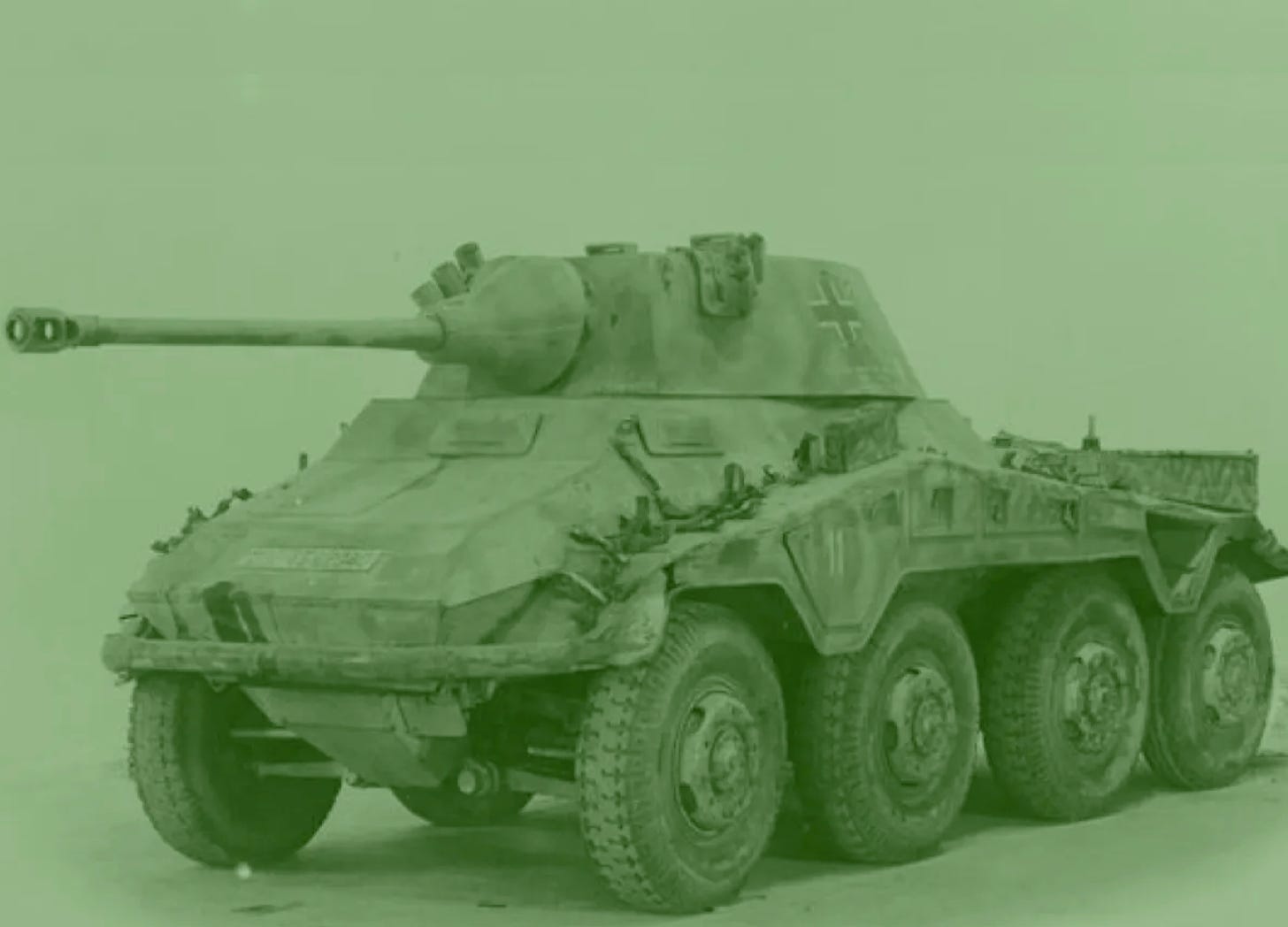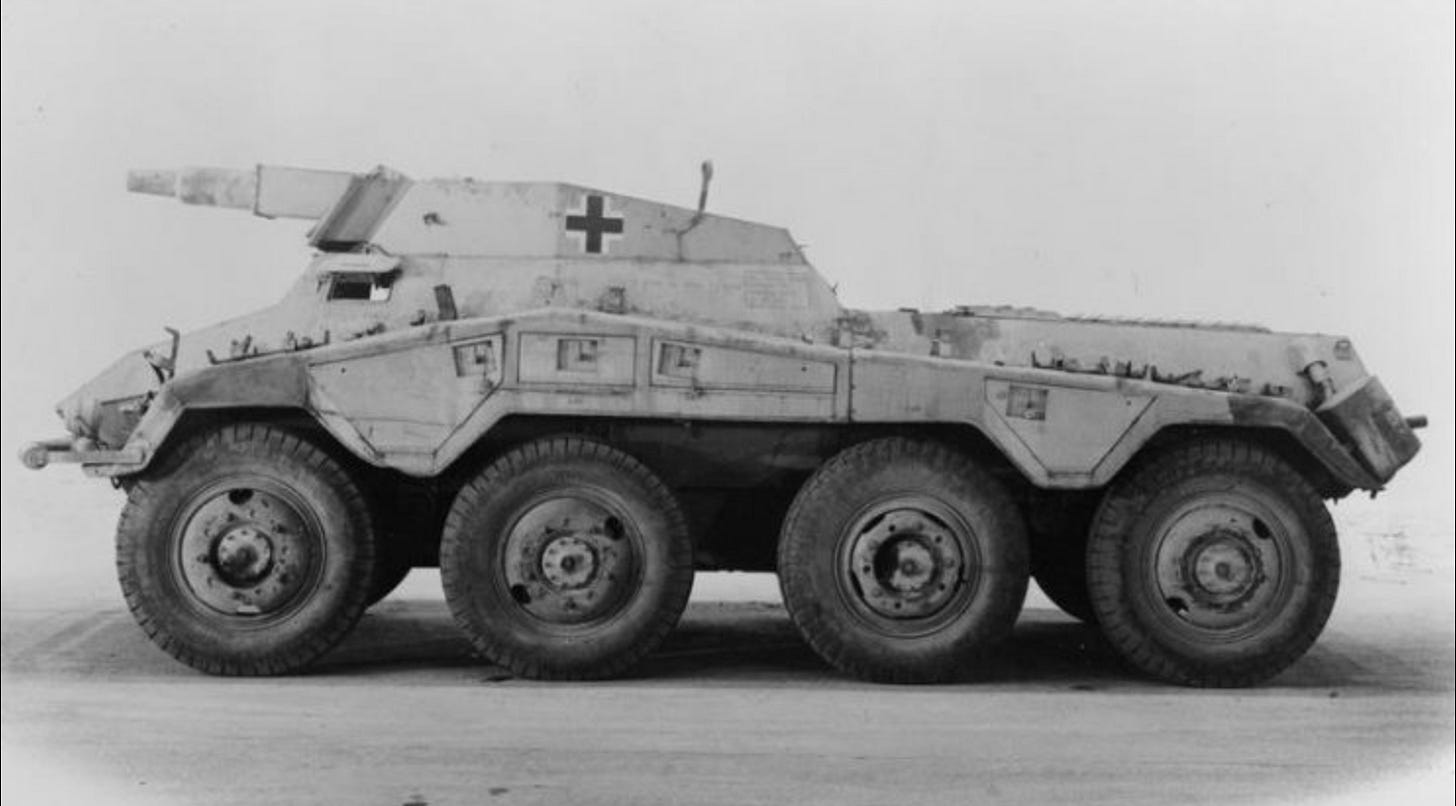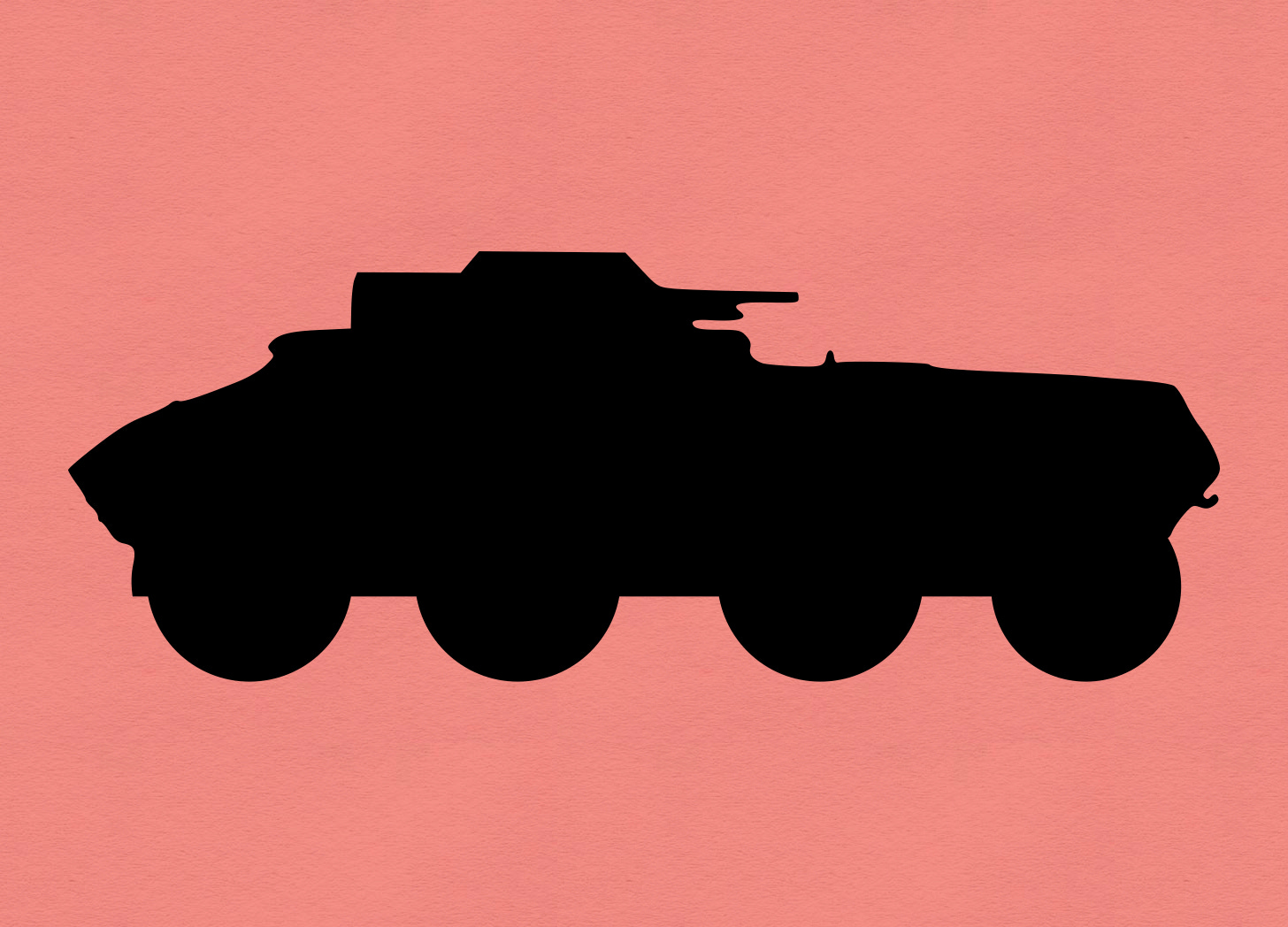The second feature article of the first issue of the Armored Forces Newsletter compares twenty-five mistaken precepts with advice in keeping with maxims that reflect the views of the Inspector General of Armored Troops. (Those of the mistaken precepts set off with quotation marks seem to be direct quotations from after-action reports.)
Lessons about the Employment of Armored Scout Patrols
(From Reports Made by Officers of Armored Reconnaissance Battalions)
Part I: General
(1) False: Armored scout vehicles are tanks; they can take a lot of punishment and are useful in every sort of combat.
(1) Correct: Armored scout vehicles are not tanks. (Their name indicates the manner of their employment.)
(2) False: “Armored scout vehicles are so capable of cross-country movement that they can always get through.”
(2) Correct: Believe what the leader of a scout patrol tells you. He knows the capabilities and limitations of his vehicles. Scout vehicles are only capable of limited cross-country movement, deep sand and swamps stop them. Moreover, after serving for a long time, the vehicles lose some of their ability [to move over difficult ground].
(3) False: “Armored scout vehicles provide security at night.”
(3) Correct: Used alone, armored scout vehicles are poorly suited to the provision of security at night. They should be used in that way only in combination with riflemen. People in the vehicle cannot hear well, and cannot use their weapons for close combat. The crews become too tired for employment during the day. So, withdraw your scout vehicles at night for rearming, refueling, and maintenance.
(4) False: “Armored scout patrols scout at night.”
(4) Correct: The nocturnal employment of an armored scout patrol is not the rule. Poor visibility. The sound of its engines betrays its presence at a distance. The equipment can easily become involved in an accident.
(5) False: [Placing] a scout patrol in a fixed position within range of enemy weapons during the day.
(5) Correct: Let the scout patrol move freely. Its strength lies in flexibility.
(6) False: Allowing scout patrols to remain in contact with enemy forces until dark.
(6) Correct: It is better to tell the scout patrol “the scout patrol will return to the battalion as soon as it gets dark,” because it sees poorly at night and in broken ground is prone to breakdowns. Otherwise command “the scout patrol will spend the night as a standing listening post.” It must therefore change its position.
(7) False: Giving a scout patrol a particular route to follow.
(7) Correct: A scout patrol should only be given a specific route to follow when it is moving ahead of the point [Spitze] of a column of march. Otherwise, orders should be limited to the reconnaissance mission [Aufklärungsauftrag] and a “direction of movement” [“Bewegunslinie”]. The best route is the one that the scout patrol picks for itself.
(8) False: Sending the armed vehicle [Waffenwagen] forward while keeping the radio vehicle [Funkwagen] in the rear.
(8) Correct: The scout patrol consists of an armed vehicle and a radio vehicle. This allows rapid reporting and the assignment of a new mission.
(9) False: Dividing the scout patrol into single vehicles for the sake of close reconnaissance [Nahaufklärung].
(9) Correct: A scout patrol should always consist of at least two vehicles, in case one breaks down. If you send a single vehicle forward, keep it within sight [of the other].
(10) False: Requiring continuous readiness for immediate employment [Einsatzbereitschaft].
(10) Correct: It takes twenty-to-thirty minutes to prepare vehicles for movement and ensure that every crewman understands the new mission. In winter, engines need time to warm up.
(11) False: “The scout patrol must figure out for itself the best way to negotiate a friendly minefield.”
(11) Correct: Read the minefield diagrams. When passages are difficult, mark them. This is particularly important when returning after dark.
(12) False: “The platoon composed of eight-wheel cars armed with 75mm guns provides security.”
(12) Correct: Vehicles armed with 75mm guns should only be employed in concert with armored scout vehicles.
(13) False: Sending eight-wheel cars with 75mm guns on reconnaissance missions alone.
(13) Correct: The eight-wheeled vehicle with the 75mm gun is not a scout car, but a self-propelled gun. It reinforces armored scout patrols.
(14) False: Scout patrols sent out to establish lateral liaison are commandeered by leaders and employed to scout or fight for them.
(14) Correct: Only the commanding officer of the reconnaissance battalion has the right to give orders to scout patrols. The leader of a scout patrol is therefore forbidden to accept other orders or permit commandeering. (These things almost always lead to the loss of the scout patrol.) When in doubt, the scout patrol should radio the reconnaissance battalion for a new mission.
(15) False: Ordering a scout patrol to set up an observation post in a particular place.
(15) Correct: On the ground, one often finds good locations for observation posts that were not evident on the map. Allow the scout leader freedom of action.
(16) False: “The armored reconnaissance battalion assigns a scout patrol to remain with the division headquarters on a permanent basis.”
(16) Correct: Allow the few armored scout cars available to the [armored reconnaissance] battalion fulfill the [reconnaissance] missions that the division gives it. Other units can protect the division headquarters. It is, moreover, hard to maintain [the vehicles of] detached scout patrols.
(17) False: “The scout patrol serving in a fixed position at night is obliged to maintain, on a continuous basis, the ability to talk on the radio.”
(17) Correct: The radio set of the [headquarters of the armored reconnaissance] battalion is set up to receive messages on a continuous basis. Therefore, the scout patrol reports important observations. The latter, however, is only set up to receive messages at particular times, lest it run down its batteries and exhaust its radio operator.
(18) False: Sending a message, via radio or messenger, telling the scout patrol to hurry up.
(18) Correct: The leader of the scout patrol is responsible for his mission, his men, and his machines. No one in the rear has the right to second-guess his decisions.
(19) False: “The armored reconnaissance battalion assigns, for the sake of radio communications, radio vehicles to the tank regiment and the armored infantry regiment.
(19) Correct: Let the small number of radio cars belonging to the armored reconnaissance battalion remain with it. Radio links to other units is the business of the division’s signal battalion.
(20) False: “Hurry up! Drive from here to Y via X and find out whether enemy forces are located there.”
(20) Correct: The scout patrol must be fully briefed on the situation and have examined the situation map of the armored reconnaissance battalion. It must be informed about the enemy situation, the mission of the armored reconnaissance detachment, the most forward friendly forces, and neighboring units.
Part II: The Standing Scout Patrol
(21) False: Use of an armored reconnaissance cars as the point of an attack on a village or wood.
(21) Correct: Employ armored reconnaissance cars to surround enemy troops as they withdraw.
(22) False:
This passage consists of seven statements, all of which are “corrected” with a single paragraph.
“The progress of my infantry company has been stopped by a pair of machine guns at the edge of a wood. Drive forward and put them out of action.”
A village occupied by enemy forces. “Drive into the village. Nothing can happen to you. If I had a tank like yours, I would already be there.”
“Drive your armored scout car to the crossroads over there and, whatever happens, stop all enemy tanks.”
Said while pointing to a point on a map. “Some bunkers are located here. I believe they are not occupied. You and your tanks can safely drive past them.”
While observing in proximity to known enemy forces. “Why are you still watching? Drive faster!”
After occupying a standing position, a scout patrol receives orders to return to the armored reconnaissance battalion. “You can’t leave us alone. We have no tanks with us.”
[Said to] a scout patrol ahead of the point [of an infantry unit]. “Your tanks can do it all yourselves. All we have to do is follow.”
(22) Correct: [Armored scout cars possess] firepower, a wide radius of action, and long-range radios. Therefore, [the leader of the nearby unit] orders the [leader of the] scout patrol, “Propose courses of action for the use of armored scout cars. What is the best thing that you can do to help us in this situation.”
Part III: Single Scout Cars
(23) False: Ordering a scout car carrying a field artillery observer to occupy a particular point.
(23) Correct: Armored scout cars are well suited to service as forward observation vehicles. However, one must allow them to make use of their mobility.
(24) False: “Remain here with your scout car and pull the truck out of the ditch.”
(24) Correct: A scout car is not a tow truck. In exceptional cases, it can be used to pull [a vehicle] of its own weight.
Part IV: Conclusion
(25) False: “These reconnaissance men do nothing but create difficulties and always think that they know better [than the rest of us.]
(25) Correct: Specialized vehicles are valuable. Employed properly, crewed and led by specialists, they can do a great deal, achieving considerable success at a low cost in casualties. Employment of them by laymen leads quickly to their annihilation or breakdown.
For Further Reading:
Source: A typescript of the first issue of the Nachrichtenblatt der Panzertruppen can be found on the website of the German Federal Archive. Printed copies of subsequent issues are available at Sturmpanzer.com.
Photos: Unless in the public domain, the photos used in this series are made available through a creative commons license.









Sage advice for all scouts.
My mother asked me what a Scout did back when I was in the Scout-Observer training at Fort Knox (on M114s!). I told her we go out an get our asses shot off and hopefully tell someone what did it.